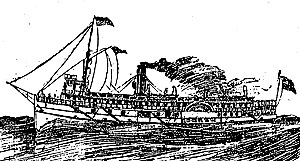|

|
| Cambria |
Sudden Panic on Lake Huron
The passengers
on the sidewheel steamer Cambria were edgy enough about the storm they were enduring on Lake Huron. Then when the vessel collided
that night with a drifting raft of logs, they experienced raw terror.
The accident happened at about 1 a.m. on July
28, 1897, while the Cambria was steaming north from Sarnia to Sault Ste. Marie. About 150 people had booked passage on the
boat for the ride.
The master of the boat, a Captain Hill, said the Cambria encountered the storm after she left the
St. Clair River and entered the open lake. After traveling for some distance, Hill said it was obvious that the storm was
getting worse. He turned the ship around and started back for Sarnia.
Shortly after making the turn, the Cambria hit
the log raft that had broken away from the tug Vigilant.
A log raft was a method of transporting logs from the many
lumber camps around the lakes to the mills, most of them located in Ohio along the Lake Erie coast. One large lumber mill
was in Tonawanda, New York. Many of the logs were shipped by boat or barge. During the Civil War, however, a shortage of vessels
created a need for alternate methods. Thus the log raft was invented.
The raft was a large frame of lumber composed
of logs that were attached to one another for towing purposes through the lakes on the way from various lumber camps to the
mills. Some of them were larger than the boats that pulled them. Some of the more powerful tugs would tow a string of rafts.
Ship masters of that period complained about the menace the rafts presented to passing vessels. When they broke lose, as this
one did, they were large, unlit obstructions capable of sinking any boat that collided with them.
The Cambria wasn't
sunk in the crash, but its wheels and machinery were wrecked. It also was found that a log stove a hole in the hull. The ship
was left to drift helplessly until it was blown ashore on the Canadian coast, near Point Edward.
One unidentified passenger
told a reporter for the Detroit Free Press what he experienced. "Suddenly there was a bump and then a series of them as the
ship crashed through the raft," he said.
"When the logs hit the wheel of the steamer the shocks were redoubled, as
then the blades were demolished. At this first shock the passengers became panic-stricken. Men, women and children rushed
from their staterooms in despair, many clad only in their nightclothes. There were shrieks and cries added to the rasping
and bumping of the logs.
"Broken glass and crockery was strewn everywhere. For half an hour an attempt was made to
extricate the vessel from the logs, but it was found impossible, and she drifted at the mercy of the sea.
"To make
matters worse, one of the steam pipes burst, the machinery could not be used, and the lights went out, precipitating everything
into inky darkness.
"For an hour the vessel pitched and tossed in the most alarming manner. The passengers and crew
had rushed at once for life preservers. Finally the boat struck the beach.
"The captain had blown signals of distress,
but we were out of the track of passing vessels. When the whistle could no longer be used, the bell was rung, and this made
the situation more weird than ever.
"My own stateroom was on the starboard side, and when we swung into the trough
of the sea, the waves covered me as I stood in the doorway. It was almost two hours after the vessel went on the beach before
the lifeboats were gotten out and the women and children were taken off to the shore.
"Fifteen trips were required
to take the 163 passengers and crew. The work was finished about five o'clock this morning."
The Cambria was left tilted
on its port side after it struck the shore. By the time salvagers arrived, some of the cabins were washed away by the seas.
It was found that one of the logs had stove a hole in the ship's wooden hull. It it hadn't drifted ashore as quickly as it
did, the steamer might have sunk.
The Cambria was salvaged and operated for several more seasons on Lake Ontario. The
vessel was wrecked on Reid's Island, in the Welland Ship Canal, in 1902.
|

